Barriers, Challenges, and Requirements for ICT Usage among Sub-Assistant Agricultural Officers in Bangladesh: Toward Sustainability in Agriculture
Abstract
1. Introduction
- (i)
- Identify the current situation of ICT usage in Bangladesh;
- (ii)
- Identify extension officers’ perceptions of the role of ICT in agriculture extension and how it helps fulfill their information needs;
- (iii)
- Identify the obstacles, barriers, and challenges faced while using ICT tools;
- (iv)
- Identify the ICT-oriented needs of the extension officers;
- (v)
- Provide possible recommendations to address the ICT needs of SAAOs.
2. Materials and Methods
2.1. Data Analysis Model
2.2. Logistic Regression
3. Results
3.1. Demography of Key Respondents
3.2. Perception of Delivering Agricultural Information According to Farmers’ Needs
3.3. Effective Tools to Disseminate Agricultural Information
3.4. Extension Approaches to Disseminate Agricultural Information to Farmers
3.5. Satisfaction with Seeking Agricultural Information from Different Sources
3.6. Collecting Agricultural Information Using Broadcast Media
3.7. Difficulties while Delivering Agricultural Information
3.8. Difficulties with Using ICT Applications
3.9. Challenges Faced with ICT Application in Agriculture Work
3.10. ICT Support Required for Performance
3.11. Issues to Overcome for Strengthening ICT Usage in Agriculture
3.12. Barriers and Suggestions for ICT Enhancement from Stakeholders
3.13. Logit Estimation for ICT Adoption
4. Discussion
5. Conclusions
Author Contributions
Funding
Institutional Review Board Statement
Informed Consent Statement
Data Availability Statement
Acknowledgments
Conflicts of Interest
References
- Okediran, O.O.; Ganiyu, R.A. E-agriculture reviewed: Theories, concepts and trends. FUOYE J. Eng. Technol. 2019, 4, 125–130. [Google Scholar] [CrossRef]
- Arokoyo, T. ICTs in the transformation of agricultural extension: The case of Nigeria. In Proceedings of the 6th Consultative Expert Meeting of CTA’s Observatory on ICTs: ICTs—Transforming Agricultural Extension? WICC/CTA, Wageningen, the Netherlands, 23–25 September 2003; p. 20. [Google Scholar]
- Zahedi, S.R.; Zahedi, S.M. Role of Information and Communication Technologies in modern agriculture. Int. J. Agric. Crop Sci. 2012, 4, 1725–1728. [Google Scholar]
- Agwu, A.E.; Uche-Mba, U.C.; Akinnagbe, O.M. Use of information communication technologies (ICTs) among researchers, extension workers and farmers in Abia and Enugu states: Implications for a national agricultural extension policy on ICTs. J. Agric. Ext. 2008, 12. [Google Scholar] [CrossRef]
- Swanson, B.E.; Rajalahti, R. Strengthening Agricultural Extension and Advisory Systems: Procedures for Assessing, Transforming, and Evaluating Extension Systems. In Agriculture and Rural Development Discussion Paper 45; The International Bank for Reconstruction and Development/The World Bank: Washington, DC, USA, 2010. [Google Scholar]
- Nyarko, D.A.; Kozári, J. Information and communication technologies (ICTs) usage among agricultural extension officers and its impact on extension delivery in Ghana. J. Saudi Soc. Agric. Sci. 2021, 20, 164–172. [Google Scholar] [CrossRef]
- Kremer, M.; Houngbo, G.F. Grow Back Better? Here’s how Digital Agriculture Could Revolutionise Rural Communities Affected by COVID-19. In World Economic Forum. 2021. Available online: https://www.weforum.org/agenda/2020/07/digital-agriculture-technology (accessed on 21 November 2022).
- Daum, T. ICT Applications in Agriculture. In Encyclopedia of Food Security and Sustainability; Ferranti, P., Berry, E.M., Anderson, J.R., Eds.; Elsevier: Amsterdam, The Netherlands, 2019; Volume 1, pp. 255–260. [Google Scholar] [CrossRef]
- Martey, E.; Etwire, P.M.; Kuwornu, J.K. Economic impacts of smallholder farmers’ adoption of drought-tolerant maize varieties. Land Use Policy 2020, 94, 104524. [Google Scholar] [CrossRef]
- Flora, C.B. Building sustainable agriculture: A new application of farming systems research and extension. In Integrating Sustainable Agriculture, Ecology, and Environmental Policy, 1st ed.; Routledge: Oxfordshire, UK, 1992; pp. 37–49. [Google Scholar] [CrossRef]
- Nedumaran, S.; Ravi, N. Agriculture extension system in India: A meta-analysis. Res. J. Agric. Sci. 2019, 10, 473–479. [Google Scholar]
- Norton, G.W.; Alwang, J. Changes in agricultural extension and implications for farmer adoption of new practices. Appl. Econ. Perspect. Policy 2020, 42, 8–20. [Google Scholar] [CrossRef]
- Kassem, H.S.; Aldosari, F.O.; Baig, M.B.; Muneer, S.; Elmajem, A.N. Researchers’ and extension workers’ perspectives on agricultural research-extension linkages in the kingdom of Saudi Arabia. J. Anim. Plant Sci. 2018, 28, 1516–1522. [Google Scholar]
- Davis, K.; Franzel, S. Extension and Advisory Services in 10 Developing Countries: A Cross-country Analysis. USAID, Feed the Future Developing Local Extension Capacity (DLEC) Project, Washington DC. Available online: https://www.digitalgreen.org/wp-content/uploads/2017/09/EAS-in-Developing-Countries-FINAL.pdf (accessed on 20 November 2022).
- Tata, J.S.; McNamara, P.E. Impact of ICT on agricultural extension services delivery: Evidence from the Catholic Relief Services SMART skills and Farmbook project in Kenya. J. Agric. Educ. Ext. 2018, 24, 89–110. [Google Scholar] [CrossRef]
- Birkhaeuser, D.; Evenson, R.E.; Feder, G. The economic impact of agricultural extension: A review. Econ. Dev. Cult. Change 1991, 39, 607–650. [Google Scholar] [CrossRef]
- Kaini, B.R. Roles of information and Communication Technologies (ICTs) to Alleviate Poverty through Agricultural Development: ICTs Initiatives in Agricultural Research and Extension System. In Proceedings of the Regional Workshop on Role of Information and Communication Technology (ICT) for Poverty Alleviation Through Agricultural Development in SAARC Countries, Dhaka, Bangladesh, 22–23 October 2003. [Google Scholar]
- Uzun, V.; Shagaida, N.; Lerman, Z. Russian agriculture: Growth and institutional challenges. Land Use Policy 2019, 83, 475–487. [Google Scholar] [CrossRef]
- Rao, N.H. A framework for implementing information and communication technologies in agricultural development in India. Technol. Forecast. Soc. Change 2007, 74, 491–518. [Google Scholar] [CrossRef]
- Westrup, C.; Al Jaghoub, S.; El Sayed, H.; Liu, W. Taking culture seriously: ICTs, cultures and Development. In The Digital Challenge: Information Technology in the Development Context; Madon, S., Krishna, S., Eds.; Ashgate: Hampshire, UK, 2003; pp. 13–27. [Google Scholar]
- Heo, P.S.; Lee, D.H. Evolution of the linkage structure of ICT industry and its role in the economic system: The case of Korea. Inf. Technol. Dev. 2019, 25, 424–454. [Google Scholar] [CrossRef]
- Ponelis, S.R.; Holmner, M.A. ICT in Africa: Building a better life for all. Inf. Technol. Dev. 2015, 21, 163–177. [Google Scholar] [CrossRef]
- Woods, J. ICTs, e-learning, and simulations: Bringing knowledge-intensive management to Asian agriculture. In Proceedings of the International Federation of Information Processing, Bangalore, India, 28–31 May 2002. [Google Scholar]
- Chamala, S.; Shingi, P.M. Establishing and Strengthening Farmer Organizations: A Reference Manual. Chapter 21 in Swanson, B.E.; Bentz, R.P.; Sofranko, A.J. editors. Improving agricultural extension. A reference manual. Food and Agriculture Organization of the United Nations Rome, Italy. 1997. Available online: http://www.fao.org/docrep/W5830E/w5830e0n.htm (accessed on 21 November 2022).
- Richardson, D. How can agricultural extension best harness ICTs to improve rural livelihoods in developing countries. ICT Agric. Perspect. Technol. Innov. 2005, 6, 1–8. [Google Scholar]
- Aryal, J.P.; Maharjan, S.; Erenstein, O. Understanding factors associated with agricultural mechanization: A Bangladesh case. World Dev. Perspect. 2019, 13, 1–9. [Google Scholar] [CrossRef]
- DAE. National Agricultural Extension Policy (Bangla Version Only), 2020. Department of Agricultural Extension (DAE), Ministry of Agriculture, Peoples’ Republic of Bangladesh. Available online: http://www.dae.gov.bd/sites/default/files/files/dae.portal.gov.bd/policies/c25c9c30_d721_4891_8014_27511d954a1b/2021-08-25-05-59-06c70c657fd941f773321c46e279df03.pdf (accessed on 21 November 2022).
- Uddin, M.N. Agricultural extension services in Bangladesh: A review study. Department of Agricultural Extension Education, Bangladesh Agricultural University, Bangladesh. Bull. Inst. Vocat. Tech. Educ. 2008, 5, 119–130. [Google Scholar]
- Hasan, S.S.; Turin, M.Z.; Sabina, S. Bangladeshi extension workers attitude towards sustainable agriculture. Acad. J. Agric. Res. 2015, 3, 312–320. [Google Scholar] [CrossRef]
- Afrad, S.I.; Wadud, F.; Babu, S.C. Reforms in agricultural extension service system in Bangladesh. In Agricultural Extension Reforms in South Asia; Babu, S.C., Joshi, P.K., Eds.; Academic Press: London, UK, 2019; pp. 13–40. [Google Scholar] [CrossRef]
- Kabir, K.H.; Hassan, F.; Mukta, M.Z.N.; Roy, D.; Darr, D.; Leggette, H.; Ullah, S.A. Application of the technology acceptance model to assess the use and preferences of ICTs among field-level extension officers in Bangladesh. Digit. Geogr. Soc. 2022, 3, 100027. [Google Scholar] [CrossRef]
- Eastwood, C.R.; Chapman, D.F.; Paine, M.S. Networks of practice for co-construction of agricultural decision support systems: Case studies of precision dairy farms in Australia. Agric. Syst. 2012, 108, 10–18. [Google Scholar] [CrossRef]
- Sarker, M.; Kaiser, A.; Miah, M. Extension Workers’ Attitude towards e-Agriculture: A case study from Bangladesh. Int. J. Agric. Sci. Res. Technol. Ext. Educ. Syst. 2019, 9, 149–162. [Google Scholar]
- Paudel, R.; Baral, P.; Lamichhane, S.; Marahatta, B.P. ICT Based Agro-Advisory Services in Nepal. J. Inst. Agric. Anim. Sci. 2018, 35, 21–28. [Google Scholar] [CrossRef]
- Chowhan, S.; Ghosh, S.R. Role of ICT on agriculture and its future scope in Bangladesh. J. Sci. Res. 2020, 26, 20–35. [Google Scholar] [CrossRef]
- Rahman, M.; Islam, M.; Ali, M. Exploring the Role of Union Digital Center to Managing Information Services in Rural Development of Bangladesh. Bangladesh J. Public Adm. 2020, 28, 38–66. [Google Scholar] [CrossRef]
- Das, S. Enhancing the Role of ICT in Disseminating Agricultural Information to Farmers in Bangladesh. Ph.D. Thesis, University of Dhaka, Dhaka, Bangladesh, 2017. [Google Scholar]
- Maulu, S.; Hasimuna, O.J.; Mutale, B.; Mphande, J.; Siankwilimba, E. Enhancing the role of rural agricultural extension programs in poverty alleviation: A review. Cogent Food Agric. 2021, 7, 1886663. [Google Scholar] [CrossRef]
- Knook, J.; Eory, V.; Brander, M.; Moran, D. Evaluation of farmer participatory extension programmes. J. Agric. Educ. Ext. 2018, 24, 309–325. [Google Scholar] [CrossRef]
- Lwoga, E.T.; Chigona, W. Characteristics and factors that differentiate Internet users and non-users as information seekers. Inf. Dev. 2017, 33, 447–462. [Google Scholar] [CrossRef]
- Anderson, J.R.; Feder, G. Agricultural extension. Handb. Agric. Econ. 2007, 3, 2343–2378. [Google Scholar] [CrossRef]
- Quddus, A.; Kropp, J.D. Constraints to agricultural production and marketing in the lagging regions of Bangladesh. Sustainability 2020, 12, 3956. [Google Scholar] [CrossRef]
- Rahman, T.; Bhuiyan, S.H. Multipurpose community telecenters in rural Bangladesh: A study of selected Union Information and Service Centers. Inf. Dev. 2016, 32, 5–19. [Google Scholar] [CrossRef]
- Rahman, T.; Ara, S.; Khan, N.A. Agro-information service and information-seeking behaviour of small-scale farmers in rural Bangladesh. Asia-Pac. J. Rural. Dev. 2020, 30, 175–194. [Google Scholar] [CrossRef]
- Takahashi, K.; Muraoka, R.; Otsuka, K. Technology adoption, impact, and extension in developing countries’ agriculture: A review of the recent literature. Agric. Econ. 2020, 51, 31–45. [Google Scholar] [CrossRef]
- Biswas, A.; Haque, A.S.; Akanda, M.G.R.; Debnath, P. Communication exposure of sub-assistant agriculture officers (SAAOs) towards e-agriculture in Khulna district of Bangladesh. Arch. Agric. Environ. Sci. 2019, 4, 434–441. [Google Scholar] [CrossRef]
- Kamruzzaman, M.; Chowdhury, A.; Van Paassen, A.; Ganpat, W. Extension agents’ use and acceptance of social media: The case of the Department of Agricultural Extension in Bangladesh. J. Int. Agric. Ext. Educ. 2018, 25, 132–149. [Google Scholar] [CrossRef]
- Hamid, M.I.; Datta, S.; Islam, M.M. Problems faced by the sub-assistant agriculture officers (SAAOs) working in department of agricultural extension. Res. Agric. Livest. Fish. 2020, 7, 61–73. [Google Scholar] [CrossRef]
- Steinke, J.; Ortiz-Crespo, B.; Van Etten, J.; Müller, A. Participatory design of digital innovation in agricultural research-for-development: Insights from practice. Agric. Syst. 2022, 195, 103313. [Google Scholar] [CrossRef]
- Hussain, S.G. Identification and Modeling of Suitable Cropping Systems and Patterns for Saline, Drought and Flood Prone Areas of Bangladesh. Climate Change Unit, Christian Commission for Development in Bangladesh (CCDB). 2017. Available online: https://worldcat.org/identities/lccn-n88176842/ (accessed on 21 November 2022).
- Firbank, L.G.; Heard, M.S.; Woiwod, I.P.; Hawes, C.; Haughton, A.J.; Champion, G.T.; Scott, R.J.; Hill, M.O.; Dewar, A.M.; Squire, G.R.; et al. An introduction to the Farm-Scale Evaluations of genetically modified herbicide-tolerant crops. J. Appl. Ecol. 2003, 40, 2–16. [Google Scholar] [CrossRef]
- Ben-Akiva, M.E.; Lerman, S.R.; Lerman, S.R. Discrete Choice Analysis: Theory and Application to Travel Demand; MIT Press: Cambridge, MA, USA, 1985; Volume 9. [Google Scholar]
- Train, K. Discrete Choice Methods with Simulation; Cambridge University Press: Cambridge, UK, 2003. [Google Scholar]
- Montshwe, B.K. Factors Affecting Participation in Mainstream Cattle Markets by Small-Scale Cattle Farmers in South Africa. Master’s Thesis, University of the Free State, Bloemfontein, South Africa, 2006. [Google Scholar]
- Amemiya, T. Qualitative response models: A survey. J. Econ. Lit. 1981, 19, 1483–1536. [Google Scholar]
- Maddala, G.S. Limited Department and qualitative Variables in Econometrics; Cambridge University Press: Cambridge, UK, 1983; p. 401. [Google Scholar]
- Kmenta, J. Elements of Econometrics, 2nd ed.; Macmillan Pub. Co.: New York, NY, USA, 1986. [Google Scholar]
- Pindyck, R.S.; Rubinfeld, D.L. Econometric Models and Economic Forecasts, 2nd ed.; McGraw- Hill Book Co.: New York, NY, USA, 1981. [Google Scholar]
- Gujarati, D.N. Basic Econometrics, 2nd ed.; McGraw-Hill Book Company: New York, NY, USA, 2004. [Google Scholar]
- Hosmer, D.W.; Lemeshow, S. Applied Logistic Regression; John Wiley &. Sons: New York, NY, USA, 1989. [Google Scholar]
- Maddala, G.S. Introduction to Econometrics, 3rd ed.; John Wiley & Sons: Chichester, UK, 2001. [Google Scholar]
- Singhal, T. A review of coronavirus disease-2019 (COVID-19). Indian J. Pediatr. 2020, 87, 281–286. [Google Scholar] [CrossRef]
- Samuel, S.D. COVID-19 Pandemic and Beyond: Utilizing Digital ICT Tools for Agricultural Innovation Transfer to Farmers. Int. J. Agr. Sci. Tech. 2021, 1, 1–3. [Google Scholar] [CrossRef]
- Mittal, A.; Grimm, J. ICT solutions to support local food supply chains during the COVID-19 pandemic. J. Agric. Food Syst. Community Dev. 2020, 10, 237–241. [Google Scholar] [CrossRef]
- Luthra, S.; Mangla, S.K.; Garg, D.; Kumar, A. Internet of things (IoT) in agriculture supply chain management: A developing country perspective. In Emerging Markets from a Multidisciplinary Perspective; Springer: Cham, Switzerland, 2018; pp. 209–220. [Google Scholar] [CrossRef]
- Akhmadi, H. November. Use of Information and Communication Technology (ICT) on Agricultural Marketing in Indonesia a Brief Literature Review. In Proceedings of the 4th International Conference on Food, Agriculture and Natural Resources; Atlantis Press: Paris, France, 2018; pp. 282–285. [Google Scholar] [CrossRef]
- Zhang, Y.; Wang, L.; Duan, Y. Agricultural information dissemination using ICTs: A review and analysis of information dissemination models in China. Inf. Process. Agric. 2016, 3, 17–29. [Google Scholar] [CrossRef]
- Rahman, M.A.; Mahfuz, M.U.; Ahmed, K.M.; Rajatheva, R.M.A.P. ICT based sustainable rural business opportunities in developing countries: A wireless-networked RCP-RAP approach. Am. J. Appl. Sci. 2005, 2, 1256–1260. [Google Scholar] [CrossRef][Green Version]
- Prodhan, F.A.; Afrad, M.S.I. Knowledge and perception of extension workers towards ICT utilization in agricultural extension service delivery in Gazipur district of Bangladesh. Int. J. Agric. Res. Innov. Technol. 2014, 4, 46–52. [Google Scholar] [CrossRef]
- Barakabitze, A.A.; Kitindi, E.J.; Sanga, C.; Shabani, A.; Philipo, J.; Kibirige, G. New technologies for disseminating and communicating agriculture knowledge and information: Challenges for agricultural research institutes in Tanzania. The Electron. J. Inf. Syst. Dev. Ctries. 2015, 70, 1–22. [Google Scholar] [CrossRef]
- Osumba, J.J.; Recha, J.W.; Oroma, G.W. Transform. Agric. Extension Service Delivery through Innovative Bottom–Up Climate-Resilient Agribusiness Farmer Field Schools. Sustainability 2021, 13, 3938. [Google Scholar] [CrossRef]
- Klerkx, L. Digital and virtual spaces as sites of extension and advisory services research: Social media, gaming, and digitally integrated and augmented advice. J. Agric. Educ. Ext. 2021, 27, 277–286. [Google Scholar] [CrossRef]
- Munthali, N.; Van Paassen, A.; Leeuwis, C.; Lie, R.; van Lammeren, R.; Aguilar-Gallegos, N.; Oppong-Mensah, B. Social media platforms, open communication and problem solving in the back-office of Ghanaian extension: A substantive, structural and relational analysis. Agric. Syst. 2021, 190, 103123. [Google Scholar] [CrossRef]
- Antwi-Agyei, P.; Stringer, L.C. Improving the effectiveness of agricultural extension services in supporting farmers to adapt to climate change: Insights from northeastern Ghana. Clim. Risk Manag. 2021, 32, 100304. [Google Scholar] [CrossRef]
- Raza, M.H.; Khan, G.A.; Shahbaz, B.; Saleem, M.F. Effectiveness of information and communication technologies as information source among farmers in Pakistan. Pak. J. Agric. Sci. 2020, 57, 281–288. [Google Scholar]
- Islam, M.S.; Haque, M.E.; Afrad, M.S.I.; Abdullah, H.M.; Hoque, M.Z. Utilization of ICTs in agricultural extension services of Bangladesh. Asian J. Agric. Ext. Econ. Sociol. 2017, 16, 1–11. [Google Scholar] [CrossRef]
- Hasan, S.S.; Turin, M.Z.; Ghosh, M.K.; Khalil, M.I. Assessing agricultural extension professionals opinion towards sustainable agriculture in Bangladesh. Asian J. Agric. Ext. Econ. Sociol. 2017, 17, 1–13. [Google Scholar] [CrossRef]
- Taylor, M.; Bhasme, S. Model farmers, extension networks and the politics of agricultural knowledge transfer. J. Rural. Stud. 2018, 64, 1–10. [Google Scholar] [CrossRef]
- Naveed, M.A.; Hassan, A. Sustaining agriculture with information: An assessment of rural Citrus farmers’ information behaviour. Inf. Dev. 2021, 37, 496–510. [Google Scholar] [CrossRef]
- Fabregas, R.; Kremer, M.; Schilbach, F. Realizing the potential of digital development: The case of agricultural advice. Science 2019, 366, eaay3038. [Google Scholar] [CrossRef] [PubMed]
- Roztocki, N.; Soja, P.; Weistroffer, H.R. The role of information and communication technologies in socioeconomic development: Towards a multi-dimensional framework. Inf. Technol. Dev. 2019, 25, 171–183. [Google Scholar] [CrossRef]
- Kante, M. An ICT-based extension services’ adoption model for public extension officers: A case in Mali. J. Inf. Syst. Technol. Manag. 2021, 18. [Google Scholar] [CrossRef]
- El Bilali, H.; Bottalico, F.; Ottomano Palmisano, G.; Capone, R. Information and Communication Technologies for Smart and Sustainable Agriculture. In Scientific-Experts Conference of Agriculture and Food Industry. 2020. Available online: https://link.springer.com/chapter/10.1007/978-3-030-40049-1_41 (accessed on 21 November 2022).
- Baig, M.B.; Straquadine, G.S.; Qureshi, A.M.; Hajiyev, A.; Abou Hadid, A.F. Sustainable agriculture and food security in Egypt: Implications for Innovations in agricultural Extension. In Climate Change, Food Security and Natural Resource Management; Springer: Cham, Switzerland, 2019; pp. 103–131. [Google Scholar] [CrossRef]
- Dhehibi, B.; Rudiger, U.; Moyo, H.P.; Dhraief, M.Z. Agricultural technology transfer preferences of smallholder farmers in Tunisia’s arid regions. Sustainability 2020, 12, 421. [Google Scholar] [CrossRef]
- El Bilali, H.; Allahyari, M.S. Transition towards sustainability in agriculture and food systems: Role of information and communication technologies. Inf. Process. Agric. 2018, 5, 456–464. [Google Scholar] [CrossRef]
- Laso Bayas, J.C.; Gardeazabal, A.; Karner, M.; Folberth, C.; Vargas, L.; Skalský, R.; Balkovič, J.; Subash, A.; Saad, M.; Delerce, S.; et al. AgroTutor: A mobile phone application supporting sustainable agricultural intensification. Sustainability 2020, 12, 9309. [Google Scholar] [CrossRef]
- Mapiye, O.; Makombe, G.; Molotsi, A.; Dzama, K.; Mapiye, C. Towards a revolutionized agricultural extension system for the sustainability of smallholder livestock production in developing countries: The potential role of ICTs. Sustainability 2021, 13, 5868. [Google Scholar] [CrossRef]
- Hashem, N.M.; Hassanein, E.M.; Hocquette, J.F.; Gonzalez-Bulnes, A.; Ahmed, F.A.; Attia, Y.A.; Asiry, K.A. Agro-livestock farming system sustainability during the COVID-19 era: A cross-sectional study on the role of information and communication technologies. Sustainability 2021, 13, 6521. [Google Scholar] [CrossRef]
- Alvi, M.; Barooah, P.; Gupta, S.; Saini, S. Women’s access to agriculture extension amidst COVID-19: Insights from Gujarat, India and Dang, Nepal. Agric. Syst. 2021, 188, 103035. [Google Scholar] [CrossRef] [PubMed]
- Li, B.; Zhuo, N.; Ji, C.; Zhu, Q. Influence of Smartphone-Based Digital Extension Service on Farmers’ Sustainable Agricultural Technology Adoption in China. Int. J. Environ. Res. Public Health 2022, 19, 9639. [Google Scholar] [CrossRef] [PubMed]
- Kassem, H.S.; Alotaibi, B.A.; Ghoneim, Y.A.; Diab, A.M. Mobile-based advisory services for sustainable agriculture: Assessing farmers’ information behavior. Inf. Dev. 2021, 37, 483–495. [Google Scholar] [CrossRef]
- Ortiz-Crespo, B.; Steinke, J.; Quirós, C.F.; van de Gevel, J.; Daudi, H.; Gaspar Mgimiloko, M.; van Etten, J. User-centred design of a digital advisory service: Enhancing public agricultural extension for sustainable intensification in Tanzania. Int. J. Agric. Sustain. 2021, 19, 566–582. [Google Scholar] [CrossRef]
- Chaudhuri, B.; Kendall, L. Collaboration without consensus: Building resilience in sustainable agriculture through ICTs. Inf. Soc. 2021, 37, 1–19. [Google Scholar] [CrossRef]
- Anik, A.R.; Rahman, S.; Sarker, J.R.; Al Hasan, M. Farmers’ adaptation strategies to combat climate change in drought prone areas in Bangladesh. Int. J. Disaster Risk Reduct. 2021, 65, 102562. [Google Scholar] [CrossRef]
- Chandio, A.A.; Sethi, N.; Dash, D.P.; Usman, M. Towards sustainable food production: What role ICT and technological development can play for cereal production in Asian–7 countries? Comput. Electron. Agric. 2022, 202, 107368. [Google Scholar] [CrossRef]
- Sourav, A.I.; Emanuel, A.W.R.; Setyohadi, D.B. Smart system architecture design in the field of precision agriculture based on IoT in Bangladesh. ICIC Express Lett. 2022, 16, 1111–1118. [Google Scholar]
- Ozaki, A.; Okayasu, T.; Rahman, M.A.; Choudhury, D.K.; Ogata, K.; Miyajima, I.; Ahmed, A.; Ohsugi, T.; Inoue, E. Potential of Informatization Agriculture in Bangladesh-Installation and Utilization of Field Monitoring System in Agriculture. In Proceedings of the International Conference on Environmental Aspects of Bangladesh, Fukuoka, Japan, 13–14 October 2012; p. 77. [Google Scholar]
- Ahmad, N.; Uday, T.I.R.; Islam, T.; Patoary, R.; Billah, M.; Ahmed, N.; Tithi, F.S. Portable mini-weather station for agricultural sector of rural area in Bangladesh. Proceedings of International Joint Conference on Computational Intelligence; Springer: Singapore, 2020; pp. 557–569. [Google Scholar]
- Khan Tithi, T.; Chakraborty, T.R.; Akter, P.; Islam, H.; Khan Sabah, A. Context, design and conveyance of information: ICT-enabled agricultural information services for rural women in Bangladesh. AI Soc. 2021, 36, 277–287. [Google Scholar] [CrossRef]
- Nord, A.; Bekunda, M.; McCormack, C.; Snapp, S. Barriers to sustainable intensification: Overlooked disconnects between agricultural extension and farmer practice in maize-legume cropping systems in Tanzania. Int. J. Agric. Sustain. 2022, 20, 576–594. [Google Scholar] [CrossRef]
- Emeana, E.M.; Trenchard, L.; Dehnen-Schmutz, K. The revolution of mobile phone-enabled services for agricultural development (m-Agri services) in Africa: The challenges for sustainability. Sustainability 2020, 12, 485. [Google Scholar] [CrossRef]
- Lajoie-O’Malley, A.; Bronson, K.; van der Burg, S.; Klerkx, L. The future (s) of digital agriculture and sustainable food systems: An analysis of high-level policy documents. Ecosyst. Serv. 2020, 45, 101183. [Google Scholar] [CrossRef]
- Sohoo, S. ICT initiative of SAARC agriculture centre in the SAARC region. In Proceedings of the 2008 International Conference on Computer Science and Information Technology, Singapore, 29 August–2 September 2008; pp. 923–929. [Google Scholar] [CrossRef]
- Biswas, M.; Anwar, M.; Stillman, L.; Oliver, G. Understanding Information and Communication Opportunities and Challenges for Rural Women Through the Sustainable Livelihood Framework. In Information for a Better World: Shaping the Global Future. iConference 2022. Lecture Notes in Computer Science; Smits, M., Ed.; Springer: Cham, Switzerland, 2022; Volume 13193, pp. 175–191. [Google Scholar] [CrossRef]
- Mazumdar, S.; Ehdeed, S.; Jimenez, A.; Ahmed, F.; Momen, S.; Rasheduzzaman, M. Understanding the information landscape in agricultural communities in rural Bangladesh. Electron. J. Inf. Syst. Dev. Ctries. 2022, e12245. [Google Scholar] [CrossRef]
- Gómez, J.S.; Bernal, L.C.M.; Blandón, J.A.R.; Díaz-José, J. The Role of Information and Communication Technologies (ICT) for Managing Sustainable Agricultural Practices: The Case of the Agricultural Extension Services in Colombia. In Knowledge Management and Sustainability; Routledge: Oxfordshire, UK, 2021; pp. 152–166. [Google Scholar]
- UNB. NEC Clears Perspective Plan to Implement Vision 2041. 2020. Available online: https://unb.com.bd/category/Bangladesh/nec-clears-perspective-plan-to-implement-vision-2041/45298 (accessed on 21 November 2022).
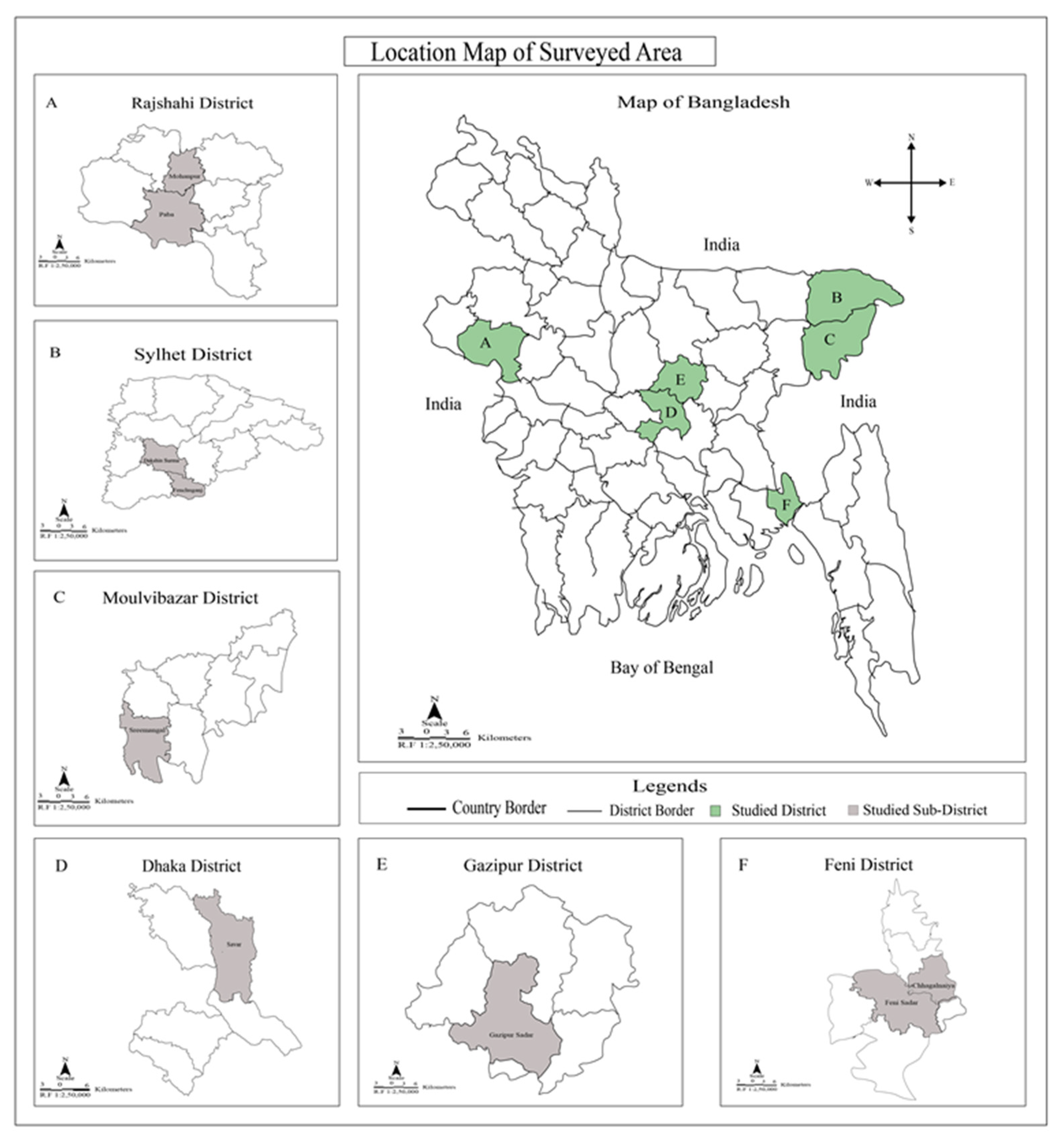
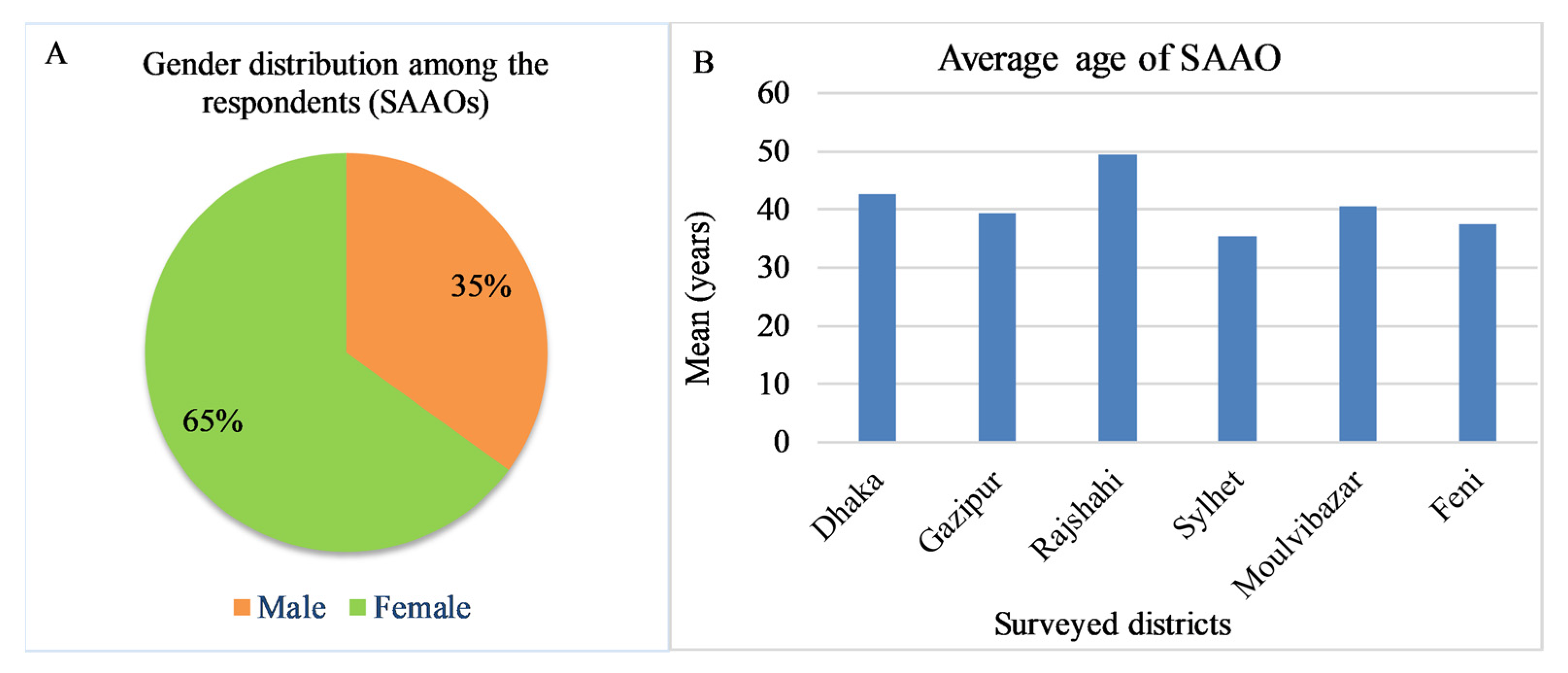
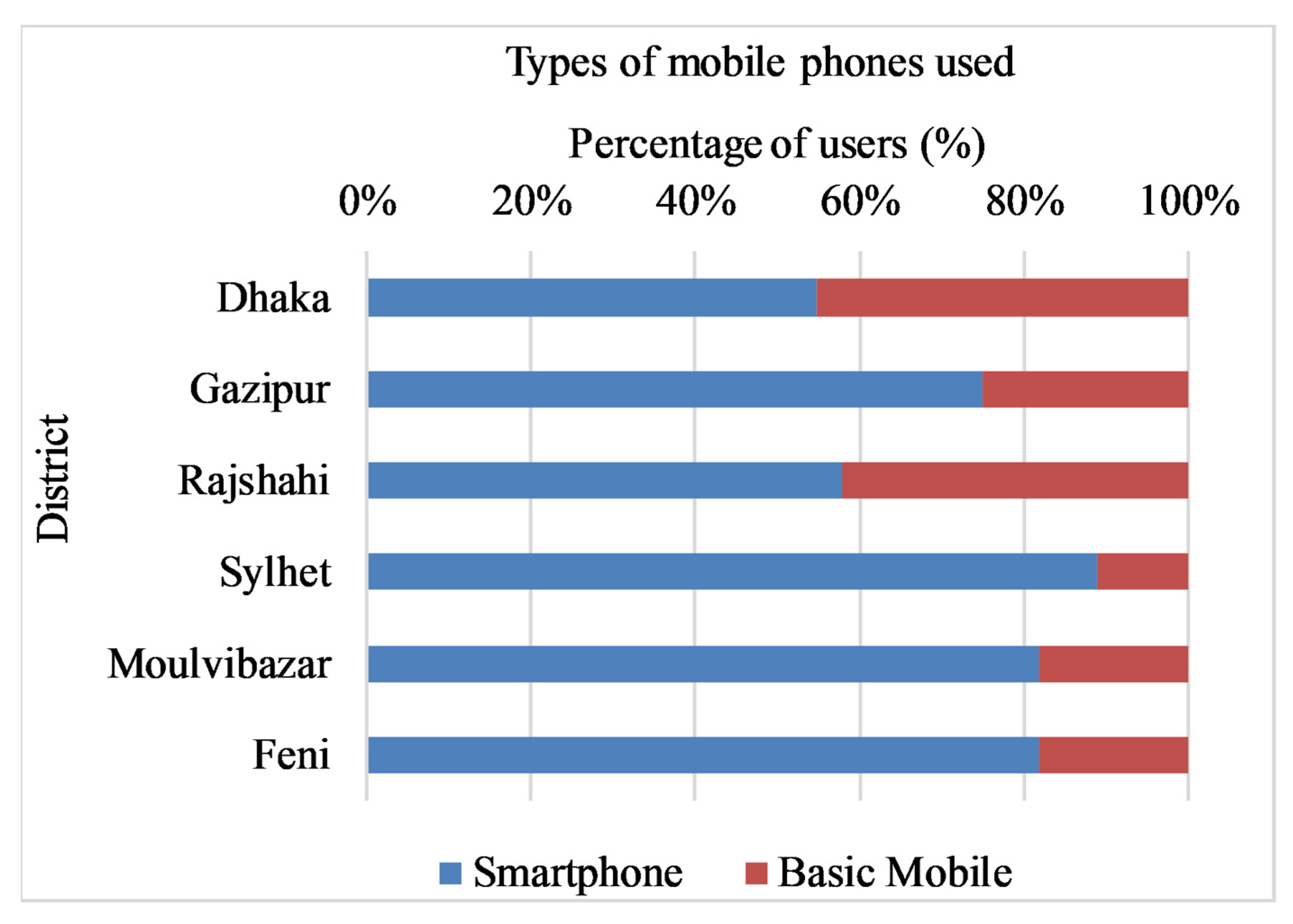
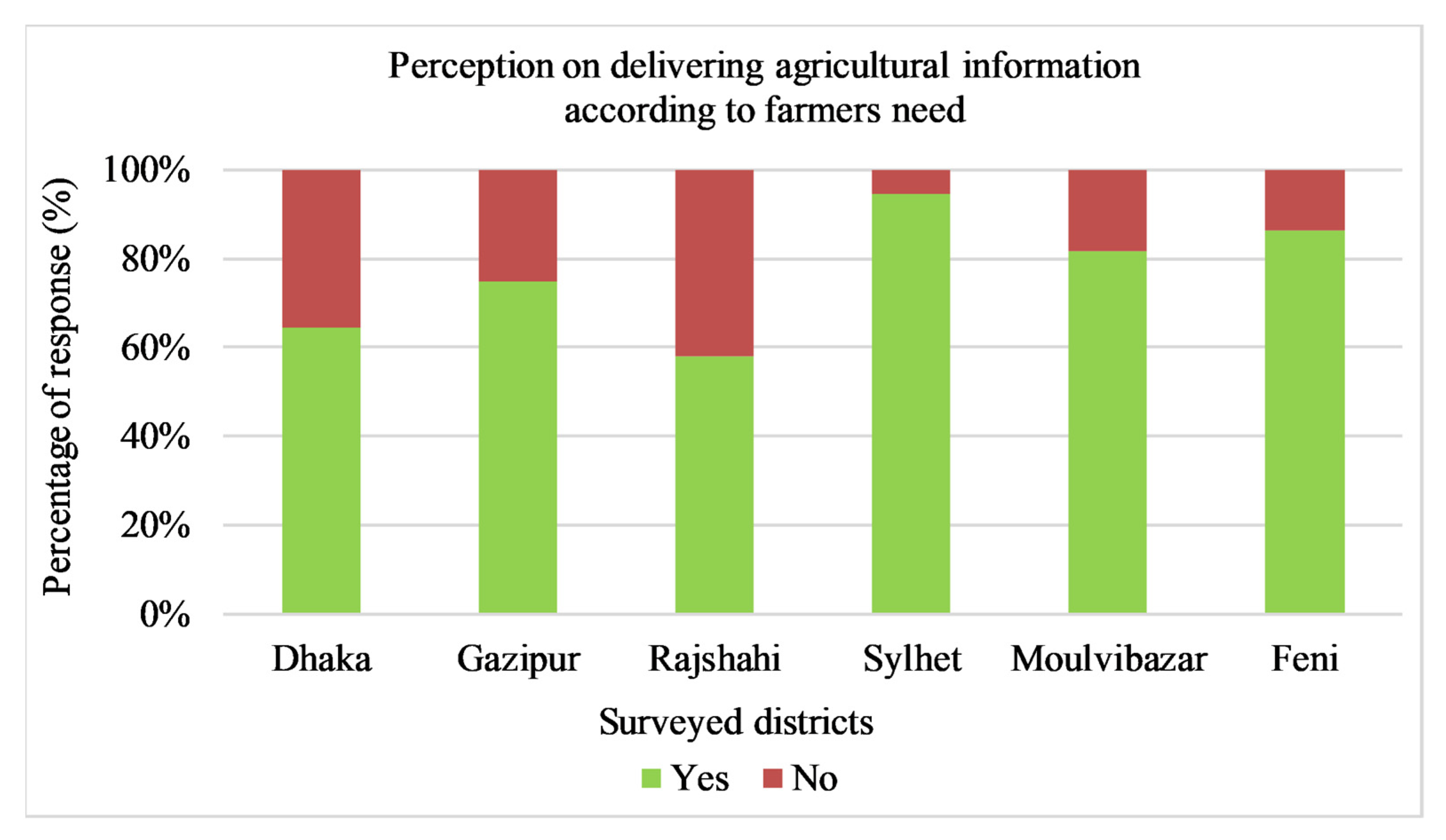

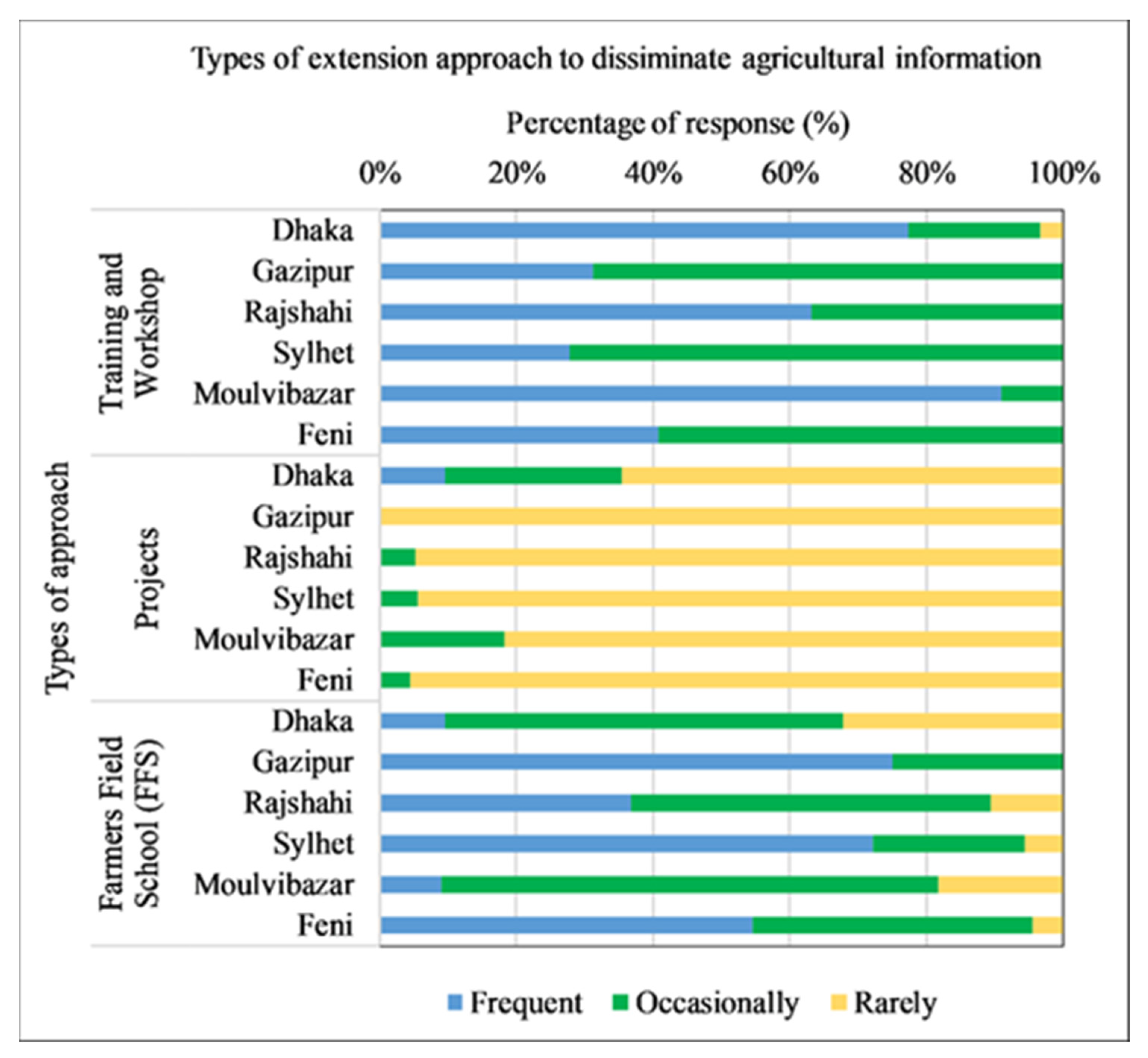
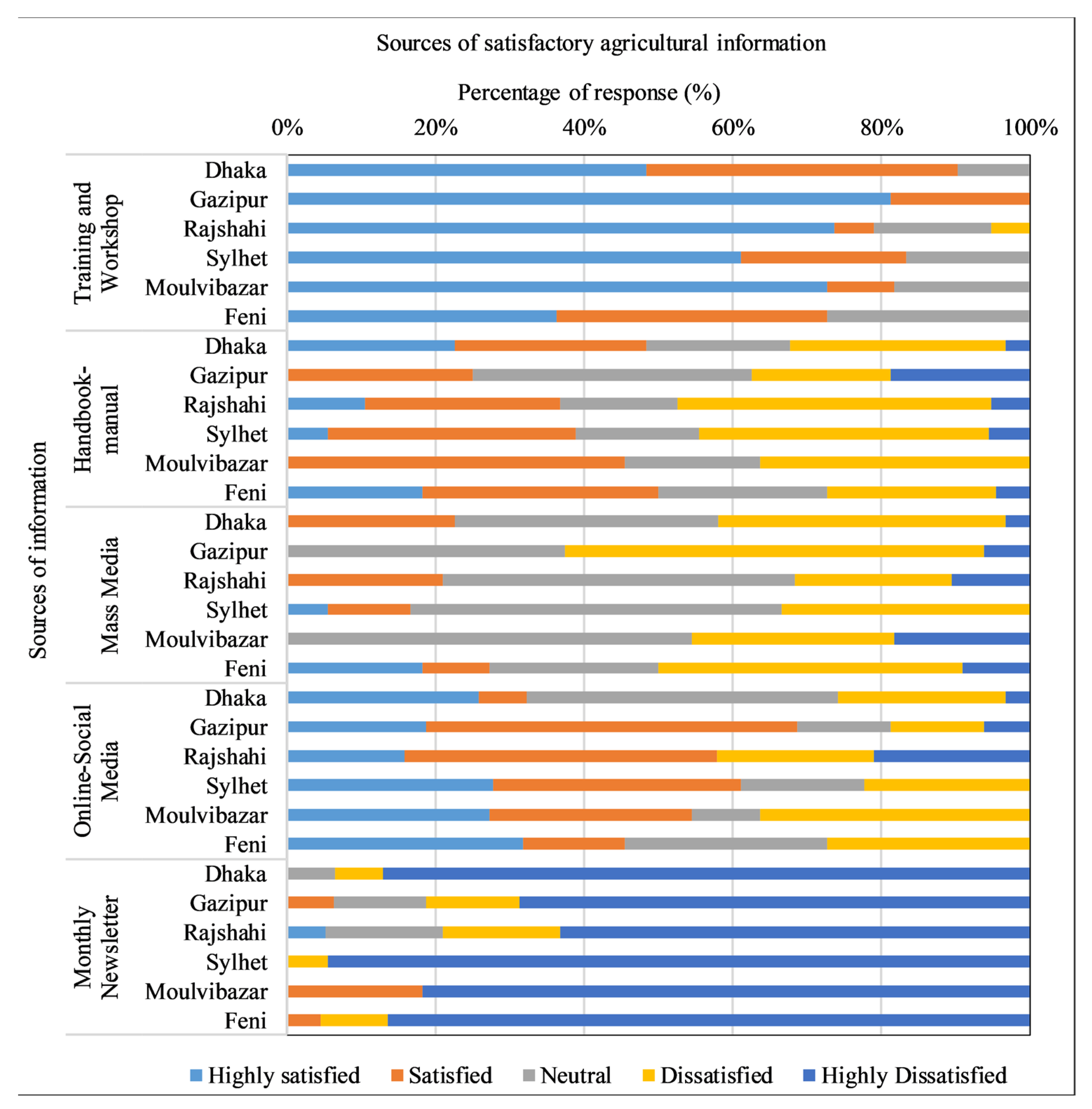
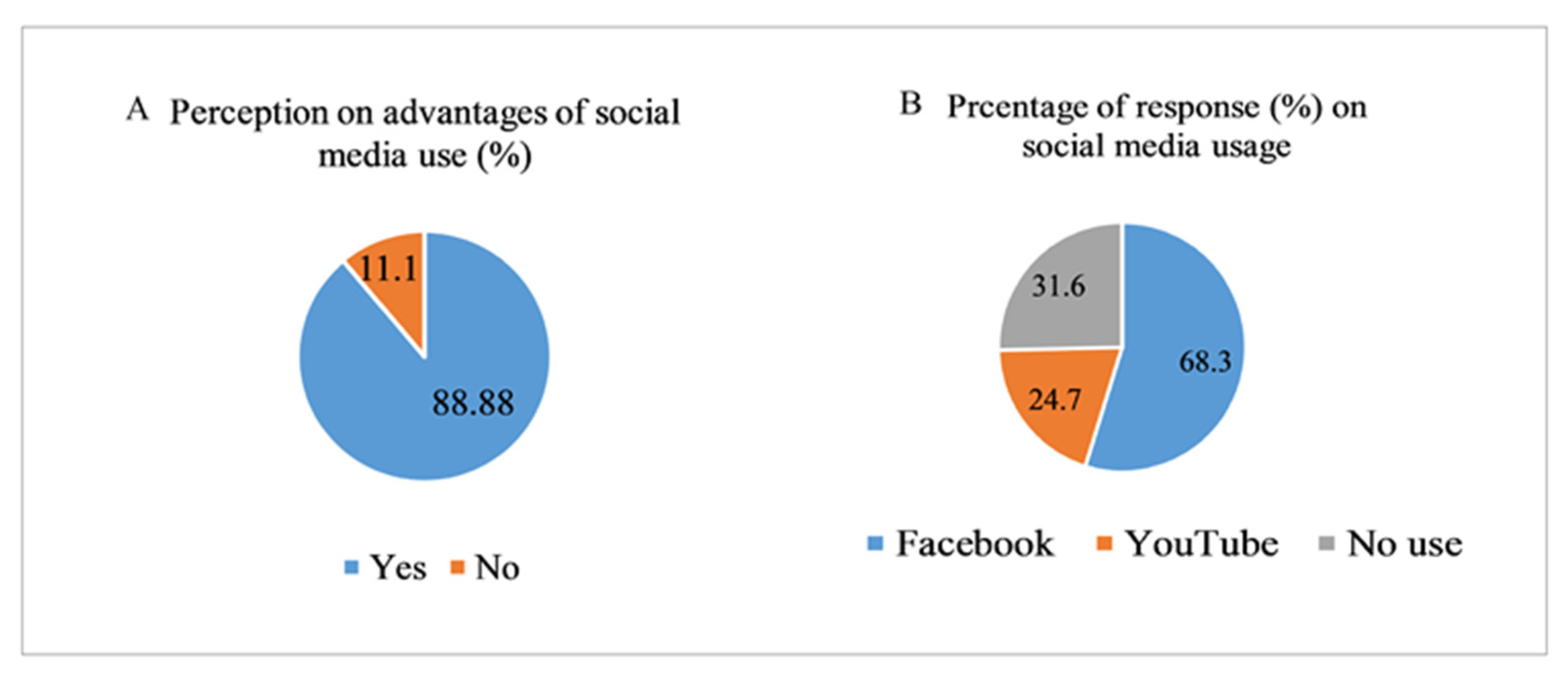
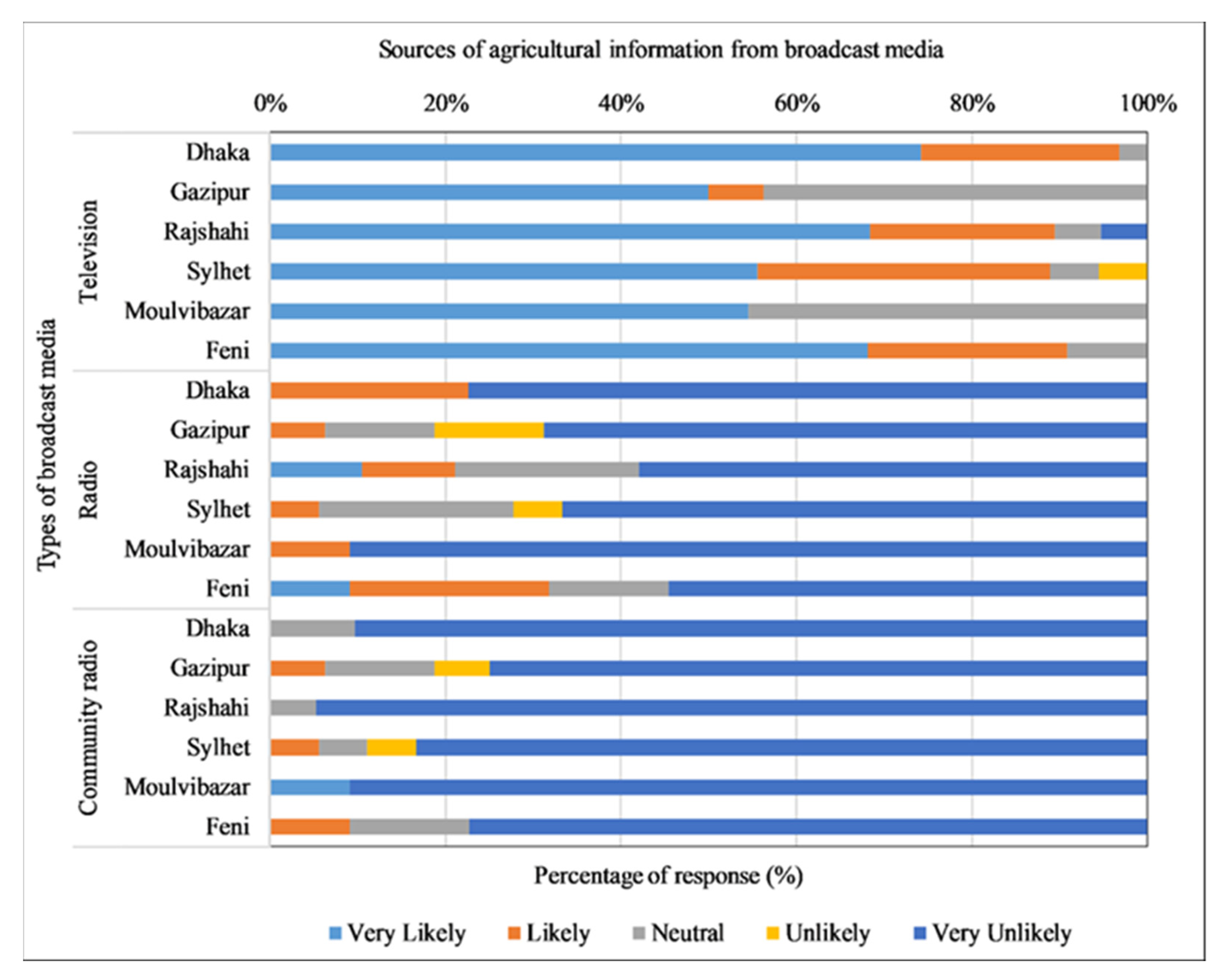


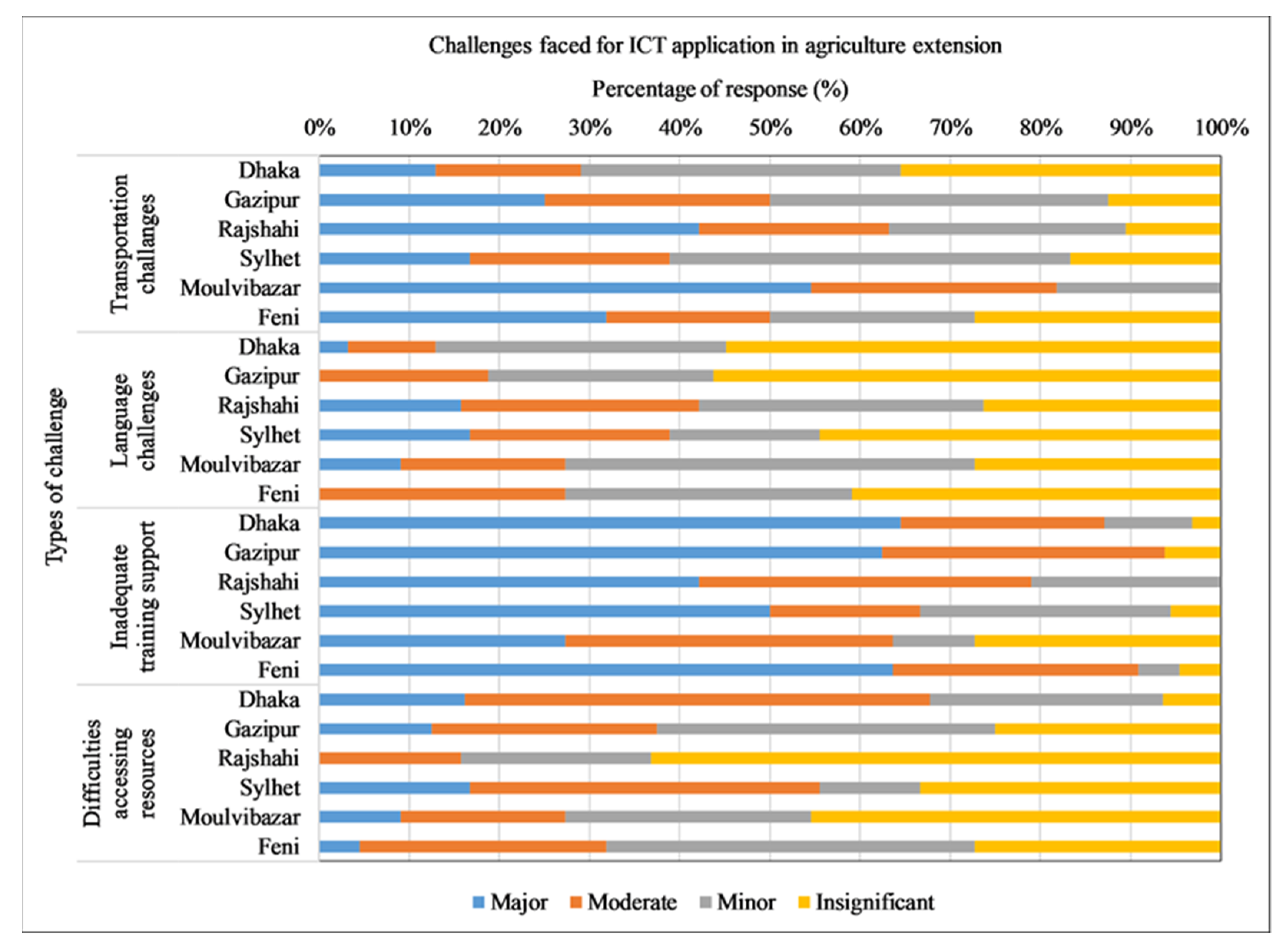
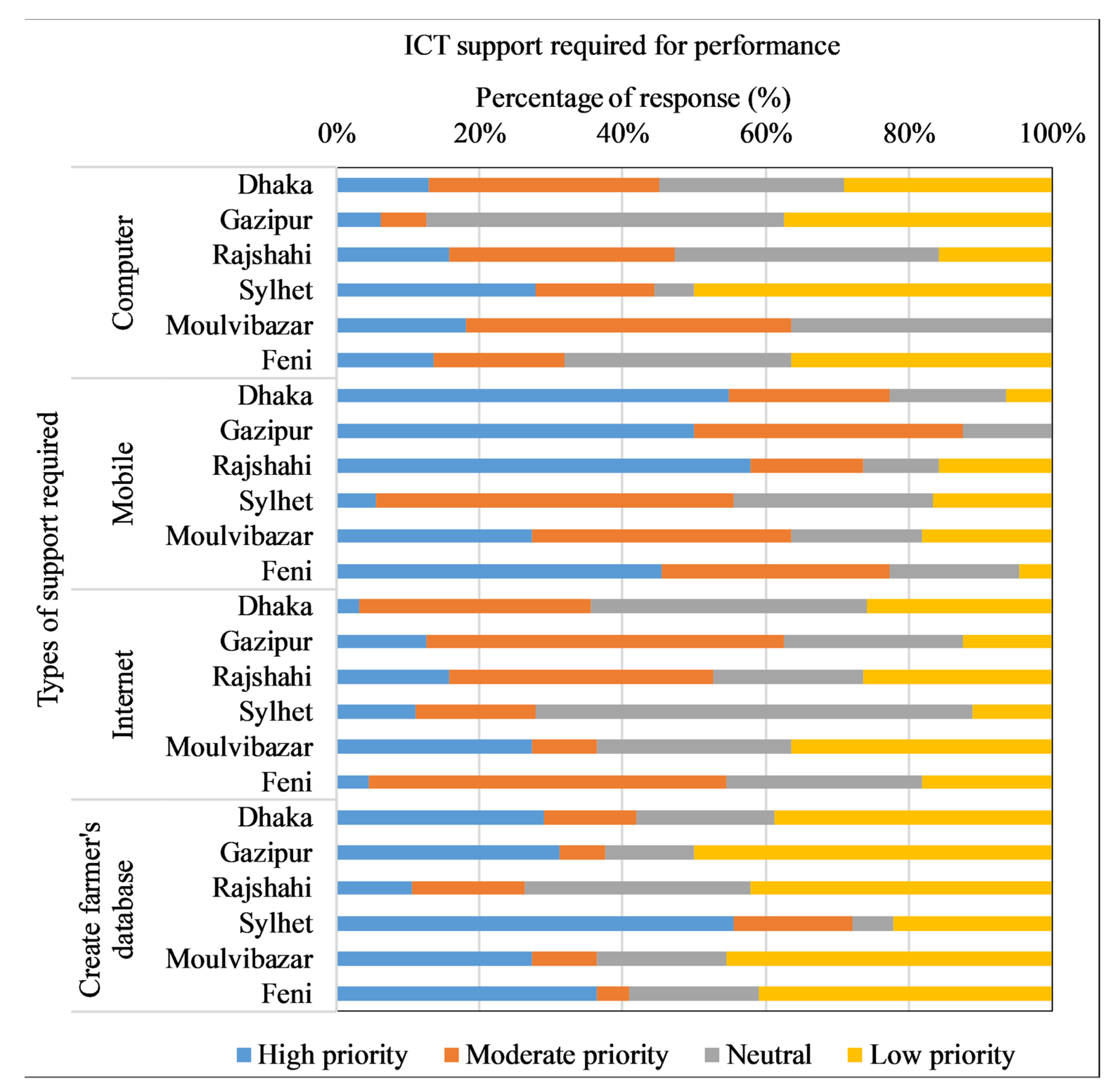

| Variable | Type | Definition and Measurement |
|---|---|---|
| Dependent variable | ||
| Adoption of ICT | Dummy | Equal to 1 if they adopted, 0 otherwise |
| Explanatory Variables | ||
| Gender | Dummy | Equal to 1 if male, 0 otherwise |
| Age | Continuous | Age (number of years) |
| Knowledge of ICT | Dummy | Equal to 1 if they have the basic knowledge, 0 otherwise |
| Use of ICT | Dummy | Equal to 1 if they already use ICT, 0 otherwise |
| Farmer’s Need | Dummy | Equal to 1 if they have the need to use ICT, 0 otherwise |
| Mobile Type | Dummy | Equal to 1 if they use a smartphone, 0 otherwise |
| Districts | Advantages of Using Social Media in Agriculture Extension |
|---|---|
| Dhaka | Most SAAOs did not use social media. Only a few described that they used it to know more about new agriculture technology (n = 9). |
| Gazipur | Quickly retrieves information and solutions related to agriculture extension (n = 8), can deliver instant responses to farmers’ needs (n = 2), know about new technology and gain knowledge on ICT (n = 1), crop-related information (n = 1), fertilizer recommendations (n = 1), diseases (n = 1), and pesticides (n = 1). |
| Rajshahi | Easily retrieves agriculture-related information (n = 3) and agricultural technology (n = 3). |
| Sylhet | Convenient to obtain information (n = 5) along with solutions (n = 4), able to give prompt replies to farmers’ queries (n = 3), know about new technology (n = 3), crop-related information (n = 1), diseases (n = 1), pesticides (n = 1), and the use of different fertilizers (n = 1). |
| Moulvibazar | Agricultural problems (n = 1), disease information (n = 1), easy to communicate (n = 1). |
| Feni | Give quick feedback to farmers’ information needs (n = 3), keep up to date themselves with new agriculture technology (n = 4), watch agriculture programs (n = 2), agriculture apps (n = 1), and agriculture information (n = 1). |
| Issues to Overcome in ICT in Agriculture | Concern Reported in District |
|---|---|
| A. Barriers faced for ICT usage | |
| Unavailability of internet connection | Gazipur, Feni, Rajshahi, Sylhet, Moulvibazar |
| Transportation barriers | Rajshahi, Sylhet, Moulvibazar |
| Internet expenses | Sylhet, Moulvibazar |
| Political interference | Sylhet |
| Farmer’s ignorance | Sylhet |
| Insufficient internet speed | Dhaka, Gazipur, Sylhet |
| ICT knowledge gap | Dhaka |
| Lack of research content | Dhaka |
| B. Factors limiting to use ICT applications | |
| ICT Training | Dhaka, Gazipur, Feni, Rajshahi, Sylhet, Moulvibazar |
| Insufficient ICT-related equipment | Dhaka, Gazipur, Feni, Rajshahi, Sylhet, Moulvibazar |
| Not enough funding | Feni |
| Irregular updating of agricultural applications | Gazipur |
| C. Factors hindering new ICT technologies | |
| Gap between research work and field requirement | Dhaka |
| Stakeholders | Organizations | Barriers | Suggestions |
|---|---|---|---|
| Government | Agriculture Extension Service provider: Agriculture Information Services (AIS) National Agricultural Technology Program (NATP) A2i (Access to Information) |
|
|
| University: Sher-e-Bangla Agriculture University (SAU) | |||
| Research Institutes: Bangladesh Rice Research Institute (BRRI) Bangladesh Agriculture Research Institute (BARI) | |||
| Private | mPower (NGO) East West University (EWU) |
|
|
| Variable | Coef | St.Err. | Marginal Effect |
|---|---|---|---|
| Gender (1 = male, 0 = female) | 0.830 | 2.503 | 0.013 |
| Age | −0.115 | 0.096 | −0.002 |
| Knowledge (yes = 1, no = 0) | 3.744 ** | 1.689 | 0.060 |
| Use of ICT (yes = 1, no = 0) | 4.552 * | 2.696 | 0.073 |
| Farmers need (yes = 1, no = 0) | 3.528 ** | 1.556 | 0.057 |
| Mobile Type (smartphone = 1, basic mobile = 0) | 2.507 | 1.786 | 0.040 |
| Constant | −3.318 | 5.461 | |
| Pseudo r-squared | 0.889 | ||
| Chi-square | 116.515 | ||
| Akaike crit. (AIC) | 28.519 | ||
| Number of obs | 117 | ||
| Prob > chi2 | 0.000 |
Disclaimer/Publisher’s Note: The statements, opinions and data contained in all publications are solely those of the individual author(s) and contributor(s) and not of MDPI and/or the editor(s). MDPI and/or the editor(s) disclaim responsibility for any injury to people or property resulting from any ideas, methods, instructions or products referred to in the content. |
© 2022 by the authors. Licensee MDPI, Basel, Switzerland. This article is an open access article distributed under the terms and conditions of the Creative Commons Attribution (CC BY) license (https://creativecommons.org/licenses/by/4.0/).
Share and Cite
Ahsan, M.B.; Leifeng, G.; Safiul Azam, F.M.; Xu, B.; Rayhan, S.J.; Kaium, A.; Wensheng, W. Barriers, Challenges, and Requirements for ICT Usage among Sub-Assistant Agricultural Officers in Bangladesh: Toward Sustainability in Agriculture. Sustainability 2023, 15, 782. https://doi.org/10.3390/su15010782
Ahsan MB, Leifeng G, Safiul Azam FM, Xu B, Rayhan SJ, Kaium A, Wensheng W. Barriers, Challenges, and Requirements for ICT Usage among Sub-Assistant Agricultural Officers in Bangladesh: Toward Sustainability in Agriculture. Sustainability. 2023; 15(1):782. https://doi.org/10.3390/su15010782
Chicago/Turabian StyleAhsan, Mamiya Binte, Guo Leifeng, Fardous Mohammad Safiul Azam, Beibei Xu, Shah Johir Rayhan, Abdul Kaium, and Wang Wensheng. 2023. "Barriers, Challenges, and Requirements for ICT Usage among Sub-Assistant Agricultural Officers in Bangladesh: Toward Sustainability in Agriculture" Sustainability 15, no. 1: 782. https://doi.org/10.3390/su15010782
APA StyleAhsan, M. B., Leifeng, G., Safiul Azam, F. M., Xu, B., Rayhan, S. J., Kaium, A., & Wensheng, W. (2023). Barriers, Challenges, and Requirements for ICT Usage among Sub-Assistant Agricultural Officers in Bangladesh: Toward Sustainability in Agriculture. Sustainability, 15(1), 782. https://doi.org/10.3390/su15010782












